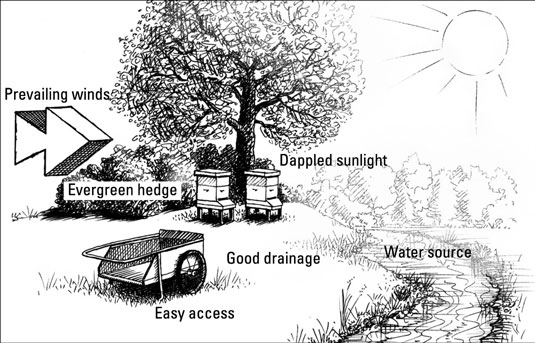Ian is often asked about the best beehive locations. Well, there are a few factors to consider, especially if you’re a backyard beekeeper with limited space and neighbours close by.
1. First, know the rules.
Particularly relevant for urban beehives, your local council will have specific rules about how far from the fence line you must locate your hive, and perhaps what direction it should face. They will also place limits on the number of hives.
2. Think about your bees’ flight path
The best way to avoid unnecessary clashes with your bees is to direct the hive entrance/exit away from dwellings and play or entertainment areas, and to encourage them to fly above your (and your neighbour’s) head.
Install a barrier, e.g a hedge or shade cloth, outside the hive entrance that is above head height. This forces the bees to fly upwards after leaving the hive. As the beekeepers at Orara Valley Honey advise, 2 to 4 metres is an ideal height.
3. Your bees need sunlight
Unless temperatures get too extreme in your area, bees will flourish in a hive that gets lots of sunlight. It helps keep the hive warm and encourages them to be active. In hotter areas, dappled sunlight or a little bit of shade may be appropriate.
4. Your bees need water, not just nectar and pollen
A reliable source of clean water is essential to your bees’ survival. Be sure to place some rocks or sticks strategically for bees to safely drink from. They can also use these to rescue themselves if they fall into the water.
5. Sweeten the deal for your neighbours
It’s best to let your neighbours know if you are planning on getting a beehive. You don’t need their permission, but letting them know that you have taken precautions can allay any concerns. And spruiking the environmental benefits of keeping bees can’t hurt!
Particularly in urban areas, you should be stocking your hive with a more docile Queen (Italians are known to be calm) as the Queen’s temperament dictates the hive’s. This may help ease concerns too.
And of course, you should be very generous with gifts of honey once the harvest arrives!
5. Other practical considerations
Does your property get strong winds? Do your hives need to be shielded from these? This may also dictate the location of your hive.
Consider ease of access and manual handling issues for yourself. The last thing you want to do is put your back out!
Your hive should be hidden from the public, to prevent unwarranted concern or even the possibility of theft.
And a note on fencing – consider if pets and livestock may cause an issue in your location. Cows have been known to knock over hives! Make sure they can’t access yours.
6. Finally, a picture.
A quick orbit of research looking for a photo came across this gem. Though it is drawn for the northern hemisphere, it illustrates many of the concepts to consider before placing your hive.
For more tips, especially for beginner and urban beekeepers, read this in-depth post from Orara Valley Honey.

Visit the Bee2Bee online shop for beekeeping equipment and supplies.




